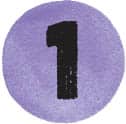ALL THINGS COLORED INK

Ink has been a favorite of many great artists, yet there are still so many mysteries left to discover.
Colored ink is a broad term that can relate to many types of inks and mediums, such as printers’ inks, tattoos, and markers. In this book, we'll focus on the liquid form of colored inks that can be used with pens and brushes.
Let’s explore all the magical types of colored inks that are perfect for a contemporary artist.

TYPES OF COLORED INKS
Every type of ink has its own unique personality and special properties. We’ll focus on the liquid form of colored inks that can be used with brushes and nib pens and even droppers that come with some bottles. We’ll also discover some inspiring and sparkling specialties.
Acrylic Inks
Acrylic ink is one of the most popular mediums because of its universal properties. Highly pigmented particles mixed with acrylic binder provide vibrancy and are resistant to fading. These inks adhere well to all sorts of papers, making it possible to work in various techniques, such as layering, washes, and collage, in combination with charcoal, paint, and even pastels. Acrylic inks have a longer working time than a medium such as acrylic paint, so there is no need to use any additives or retarders.

Acrylic Ink
Acrylic ink can be used on almost any oil-free surface after preparing it with an acrylic medium such as gesso or matte medium. Some inks have a bit of an oily or glossy surface when dry, depending on the brand, but the color remains bright. Acrylic inks can be opaque or transparent and can be applied with a brush, liner, nib pen, or an airbrush.
These inks are super lightfast. Lightfastness in colored inks is the resistance to fading when exposed to natural or artificial light. This process is caused by UV radiation. Generally, most dye-based inks are bright and transparent. You can affect an ink’s lightfastness by increasing the thickness of the layer, and although the color will inevitably fade, some parts will remain. When you mix inks, the lightfastness of the weakest ink will define the properties of the whole mix. Varnishing an artwork will help protect it from UV light. There is no need for extra protection when using lightfast inks because they are resistant to fading, but it’s a good idea to cover the finished piece with a final layer of water-based lacquer. This helps protect the artwork from dust and UV rays. Use a glossy lacquer if you want to intensify the dark colors and a matte or satin one to keep the inks light.

Acrylic ink, shellac ink, and calligraphy and drawing inks can be beautifully combined in one artwork when working on heavy paper with a minimum of 200 gsm (see here).
Shellac Inks
These inks are made with a natural shellac gum that provides brilliance and brightness under light. You can obtain a satin finish or a glossy finish with a thick application of ink. I use shellac ink for my professional work because I love the painterly feel. Inks can be both pigment- and dye-based, and they can be protected with a workable fixative, which increases their light stability.
Shellac inks can be used undiluted, which provides maximum brilliance, or they can be diluted with water. They can also be diluted with a special shellac thinner to achieve a painterly and smooth feel.

Shellac Ink
Calligraphy and Drawing Inks
I still feel overwhelmed and excited when I see myriad colorful magic ink bottles in an art supply or stationery store.
Did you know you can easily paint with calligraphy ink? Calligraphy inks and drawing inks have a lot in common and can be applied in almost the same manner. Calligraphy ink is often pigment-based, is water-resistant, and can be used with dip and fountain pens. The pigments are fully lightfast, so the inks are designed to resist fading.
Drawing inks are dye-based, which means they’ll fade over time. This property is something to consider if your artwork will be featured as a gallery piece or hung on a wall. Liquid dye-based inks are generally not waterproof when dry (except for India ink), so I don’t recommend them for layering techniques.
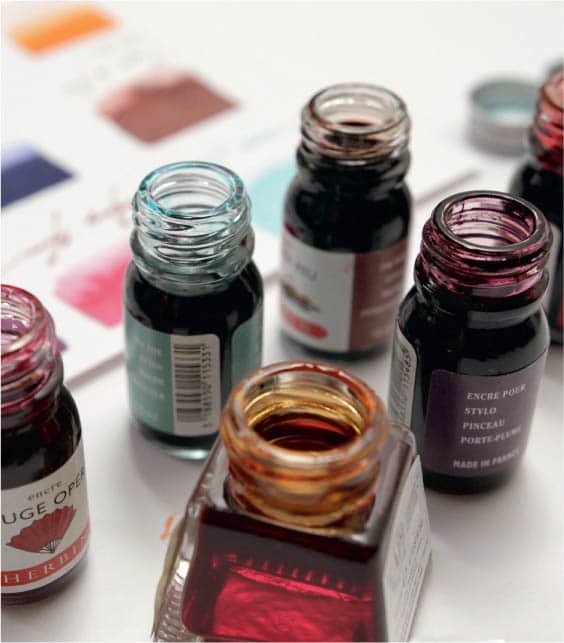
Calligraphy Ink
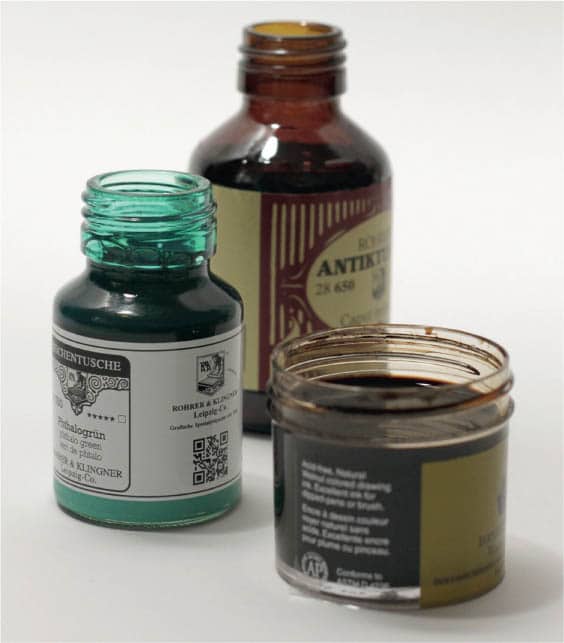
Drawing Ink
Chinese and India Inks
These two inks are the most recognizable types worldwide. As you can guess from the names, these inks originated in China and India, but materials for both are often sourced in India. The most basic or classical form of these inks are ink sticks, which are rubbed on an inkstone and mixed with a little water to produce fluid ink. Small sets can be found in art supply or calligraphy stores.
Chinese ink is water-resistant and permanent and works well with mixed-media techniques. Some manufacturers add a small amount of varnish or shellac to make the ink lightfast.

Alcohol Inks
This type of ink has become quite popular, and some artists even use it as their signature medium. Alcohol inks easily produce fantastic abstract effects with vivid colors on almost any surface, including fabric, ceramic, synthetic paper, stone paper, glass, clay, resin, and metal.
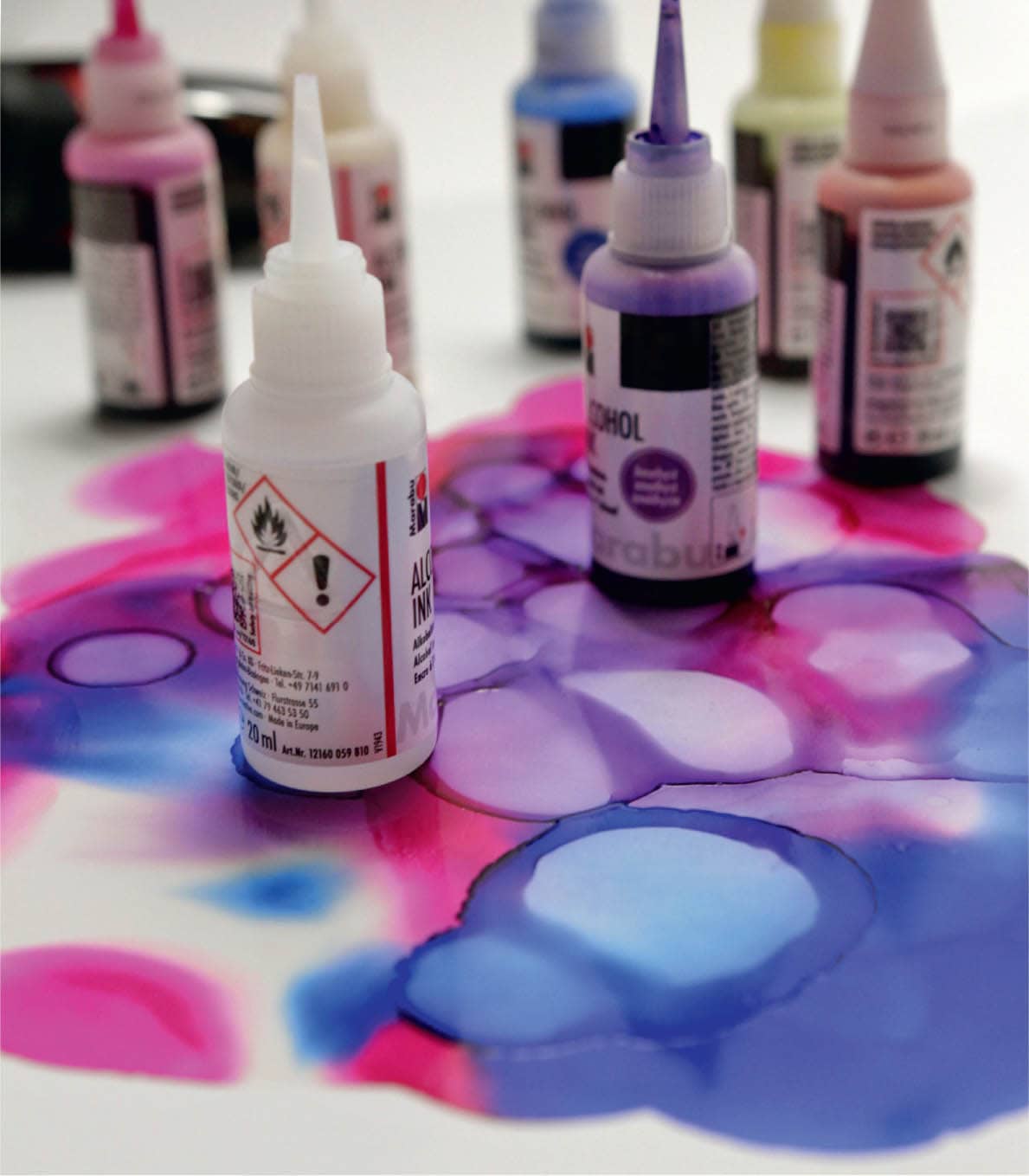
No drawing skills are needed when using alcohol inks to create abstract designs. Effects are achieved by adding isopropyl alcohol and using a heat gun to move the ink to create colorful splashes. Once the ink dries, it can be rewet, producing even more versatile effects. Different textures can appear when transparent layers are combined with opaque white and gold inks.
My favorite type of alcohol-based inks come in thin markers. These inks are mixed with alcohol and can create fantastic deep gradients and blending effects without using any water.
When working with alcohol-based inks, it’s better to work in a well-ventilated area or outside. Otherwise, it makes sense to wear a mask/respirator to protect yourself from strong evaporating alcohol fumes. Alcohol inks in bottles are very messy, splashy, and extremely fast drying when alcohol evaporates. I recommend using gloves to protect your fingers and hands.
Metallic Inks
Metallics are the most enchanting form of colored inks. These inks consist of extra-fine metallic pigments diluted in a binder such as shellac or acrylic, providing remarkable consistency and properties. Unlike other colored inks, metallic inks have a higher viscosity and various levels of shine when dry. The ink coverage, brilliance, and drying time depend on the quality, so I recommend choosing a few professional-grade bottles. You won’t need a lot, and they’ll last a long time. Gold, silver, and white pearlescent shades show the most brilliance on dark papers and objects.

SPECIAL EFFECTS
You can achieve brilliance with inks through a number of effects, such as mixing pearlescent inks with basic hues. Shades can differ greatly depending on the tone of the paper or texture of the surface. Try adding a few shining drops of bronze ink to dark shimmering ink and see what happens.

Metallic Markers
One of my favorite supplies is metallic effect markers. I use gold, bronze, and Liquid Chrome markers on various surfaces in my mixed-media projects. Liquid Chrome is a highly pigmented alcohol-based ink by Molotow that creates a stunning mirror effect. Similar effects can be achieved with bright silver markers.
These inks are opaque and work well for modern designs. I decorated these Easter eggs using just a few shades and added some interest with bold metallic elements. Such inks offer striking effects when applied to three-dimensional surfaces.
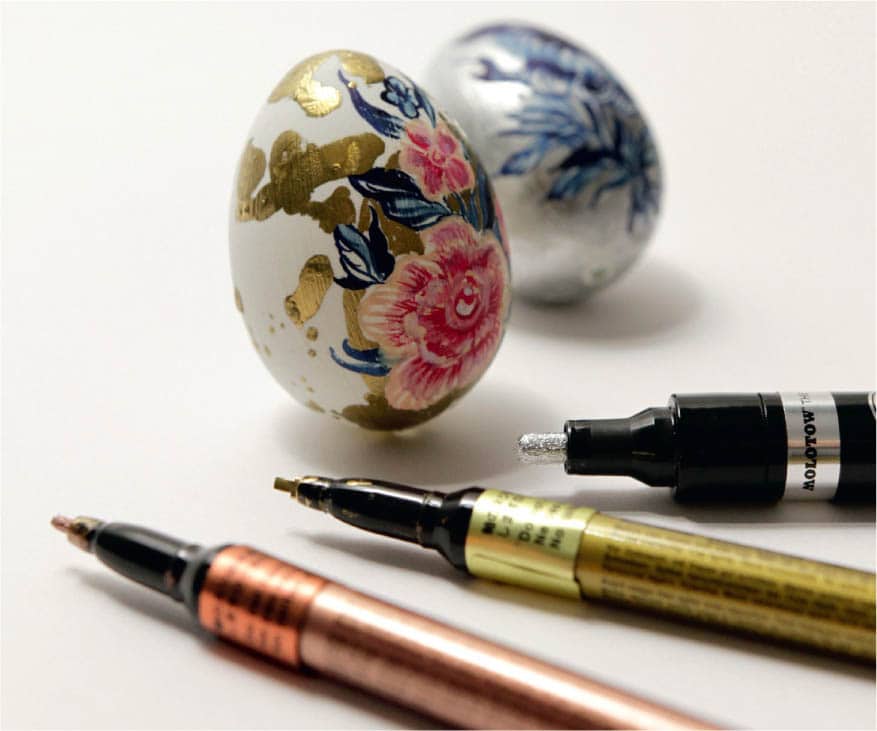
BRUSHES
Each brush has its own character. Brushes come in various shapes and sizes; the smallest is numbered with zeros (000) and goes up to 20 or 30, depending on the type of brush. Numbers 2, 3, and 6 are excellent for line drawings and inky paintings.
The good news is you don’t have to buy expensive brushes when working with inks. Inks can be used with any type of brush or no brush at all. You can use natural hair and synthetic brushes with inks according to your preference. However, I don’t recommend using natural brushes with acrylic inks because acryl can damage the hairs.
These are the brushes I use for most for my inky artwork. As you begin to work more with ink, try some of these brushes to see what they add to your artwork.
- Synthetic round watercolor brushes in various sizes: Usually three brushes, sizes 2, 3, and 6, are enough for almost any artwork.
- A French brush, or mop brush: This is specially constructed to hold a lot of water, and it allows you to make large and extra-fine brushstrokes. This brush is a favorite among many watercolor artists.
- Chinese brush or Oriental brush: This brush has a wide variety of sizes and holds water well.
- Fan brush: The shape is great for experimenting and for making unusual marks and textures. You’ll use it for the flick and spatter effects in the basic techniques chapter (see here).
- Flat wash brush: Add this to your arsenal if you use a lot of water and want to create large washes. Flat brushes also vary in size, and some artists prefer painting straight lines with sizes 3 to 6, which are helpful for rendering architecture, bricks, and trees.
PAPER
You may have seen papers made especially for ink in art supply stores. Myriad options exist. The optimal choice for inks used with pens and brushes is Bristol paper. This paper is smooth and allows you to move in any direction without damaging the pen or brush.
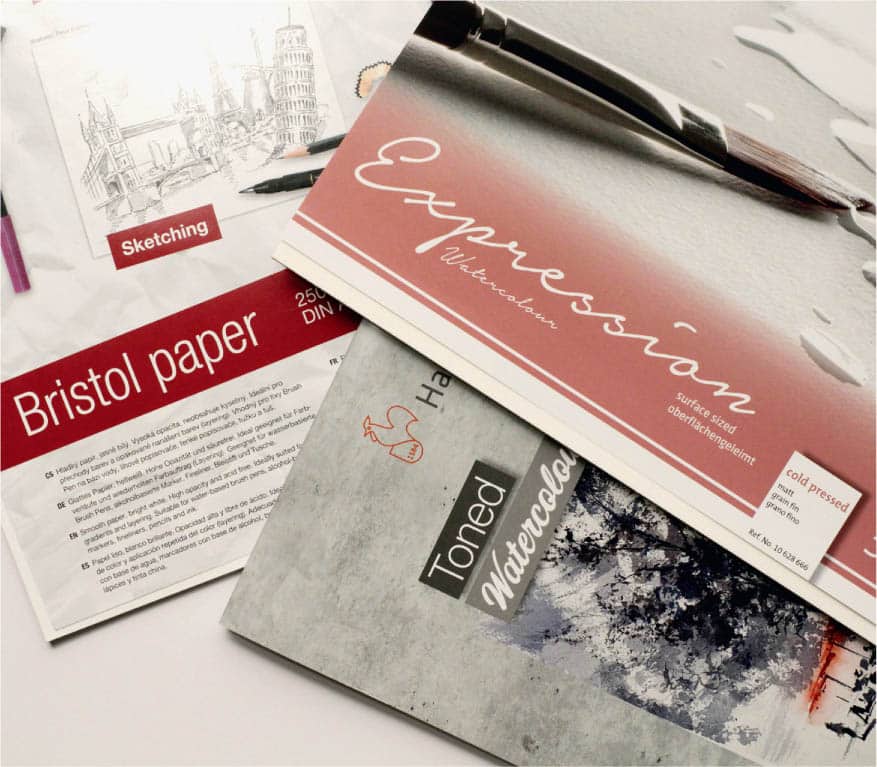
Although Bristol paper is a universal choice for any type of colored inks, every creative has a paper preference depending on their style and artistic goals. A vellum Bristol paper is less absorbent than watercolor paper but still holds enough water to add a few washes. This paper works great for pen and ink illustration, but it will wrinkle if you add a lot of water or use several layers of washes.
Your paper choice should be determined by the style and number of layers you plan to include in your work. Sometimes I work spontaneously and sometimes I scrupulously plan the painting up front, so I’ve been experimenting to find the ideal multipurpose paper that allows me to work in any style.
I’ve found that acid-free watercolor paper works best for me for colored inks. Watercolor paper comes in various weights and textures, but for ink you should use a paper with a weight of at least 250 gsm (grams per square meter) so it can hold enough water to create washes. Here are the pros and cons of the three types of watercolor paper:
- Rough: This paper has a lot of texture and tooth (surface feel) and works great for landscapes and abstract art. However, it’s not suitable for extra-fine nib pens because the nib catches on the surface, damaging both the paper and the tip.
- Hot press: This has the smoothest surface and will show tiny details and fine lines. The paper can also hold a lot of water but is less forgiving. It’s much harder to make changes such as adding multiple layers or lifting off inks because the surface has no tooth.
- Cold press: This paper, with its slightly rough finish, is my favorite. It can be used to create details and expressive lines. Cold-press paper is ideal if you plan to layer color over fine lines.
Toned and Black Paper
I remember how fascinated I was the first time I painted on gray and tan-toned watercolor paper. You can add a three-dimensional feel to any subject with just a few strokes. Since the paper provides the middle tone, you only need to add lighter and darker tones. The gray tone works well for moody, cold winter scenes, and the warm tan is great for portraits. You can also create enchanting starlight effects by applying white ink on black paper.

Sketchbooks
Before starting any sketching journey, I always think about two things: Where should I sketch, and what should I sketch? I choose a particular sketchbook based on my answers.
So many types of sketchbooks are available that choosing one can be overwhelming. These are my favorites for colored inks.
- A large hardcover notebook with a cased-in binding: The pages are sewn together in sections, but the book lies flat and is very comfortable.
- Softcover sketchbook with a saddle stitch (stapled) binding: This type of sketchbook usually has a small number of pages and might have short-term use. I use it to test brushes or collect color palettes and exercises.
- Spiral notebook: This style is extremely low-cost, so you can have a useful, affordable sketchbook to carry around.

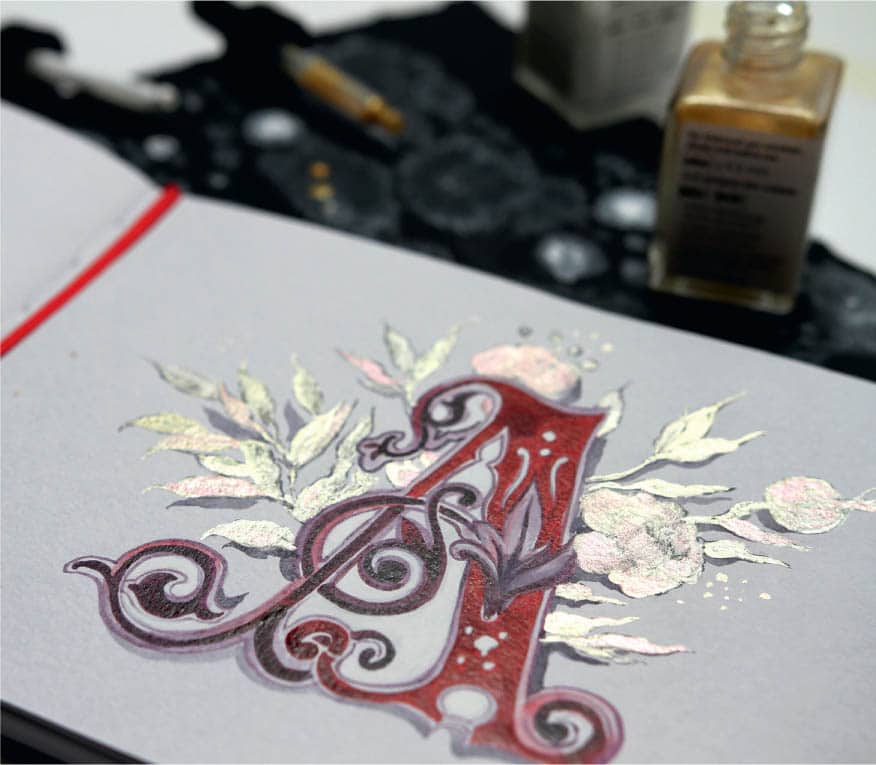
Toned watercolor sketchbooks are perfect for creating illuminated letters and other effects. I use them in the studio for thoughtful, detailed projects.
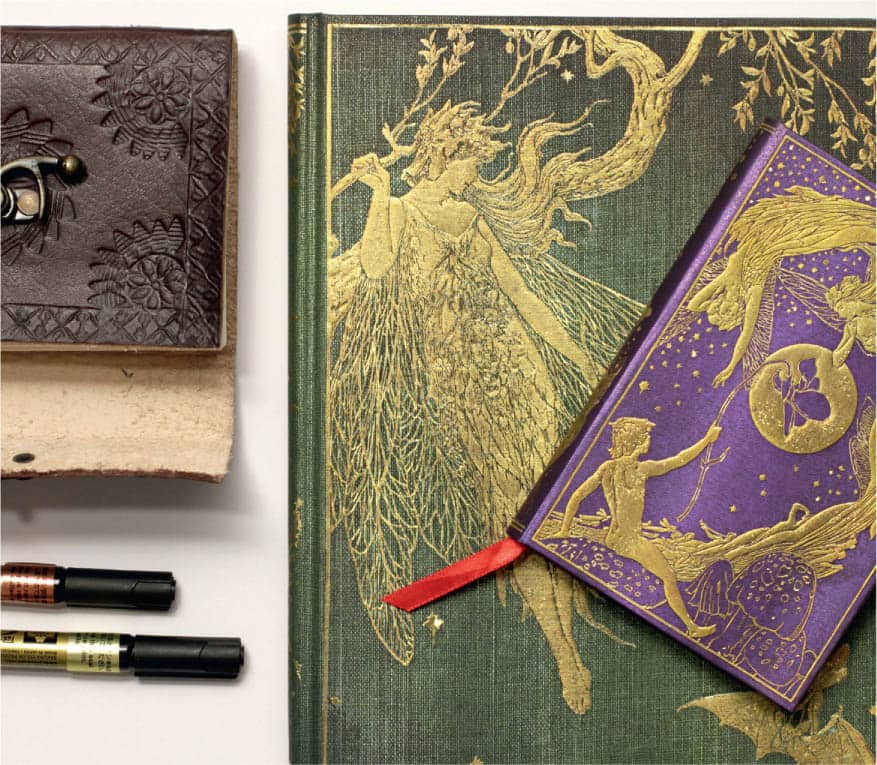
These are the most conventional types of sketchbooks. You can find varieties that look like ancient treasures, grimoires, or enchanted, illuminated manuscripts. I also love custom-made treasures.
Brush Pens
A brush pen (sometimes called a fudepen) is a drawing and writing tool that consists of a brushlike nib fed by an ink reservoir. The nib can look like an ink brush or may have a felt marker tip. Brush pens are becoming more popular these days for painting as well as calligraphy and different lettering techniques. Not surprisingly, a wide variety of options are available.
A few things should be considered when choosing a brush pen: ink flow, the versatility of the tip, and the tip’s size. These choices are personal, and you can try tester pens in art supply stores to find out which option you prefer.
Using brush pens on Bristol paper allows you to create fine lines and add a layer of watercolor on top of the ink. Good-quality brush pens provide a variety of thick and thin strokes, and synthetic tips boost creative freedom. Press hard on the tip to get a wide stroke and lift the brush to get delicate lines. Gently squeezing the plastic reservoir results in a heavier flow, depending on the pen’s design. Some brush pens have empty wells that can be filled with a unique color mix.
I’m a huge fan of extra-fine artist Japanese brush pens. The brush nib feels almost like a real paintbrush, with an extra-long brushlike tip that creates the finest lines. The pen uses replaceable colored ink cartridges, making it an excellent option for working in a sketchbook or drawing on the go. My favorites are Pentel Arts Pocket Brush Pen and Sign Pen.


Some types of brush pens come filled with colored inks, and they can be used almost like watercolors. Other types have empty wells that can be filled with your desired colored ink and applied with a fine synthetic tip.

